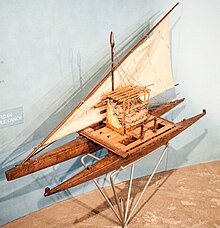Drua
No written record exists of the diffusion of the drua design, but most anthropologists assume its origin in Micronesia, and it probably came to Fiji through the islands of Kiribati and Tuvalu.
The only shunting boat type of Polynesian design is the pahi of the Tuamotu archipelago, but it uses equal hulls and does not appear to be related to other proas.
Captain Cook visited Tonga in his second and third voyages, and noticed that druas were rapidly displacing the Polynesian catamaran design.
[1]The speed of druas became a legendary topic for western sailors, who sometimes confused "Fijian canoes" with "flying proas" (the latter being the original Micronesian design).
The steering oars were massive, and big canoes would carry one at each end because they were too heavy to transport to the other side while shunting.
Few if any were constructed after 1883, the year of the death of King Cakobau, for his grandson, Ratu Popi, informed me that the king's sons two or three years later broke his double canoes to pieces and buried them in a swamp that they may be preserved and kept from being used by anyone else"[1] According to some sources, the last Fijian ndrua was built in 1943 on the island of Ongea and was intended to carry copra.
A new Drua, the i Vola Sigavou, was completed in 2016 and launched at Navua in Serua province on Viti Levu Fiji's main island.



